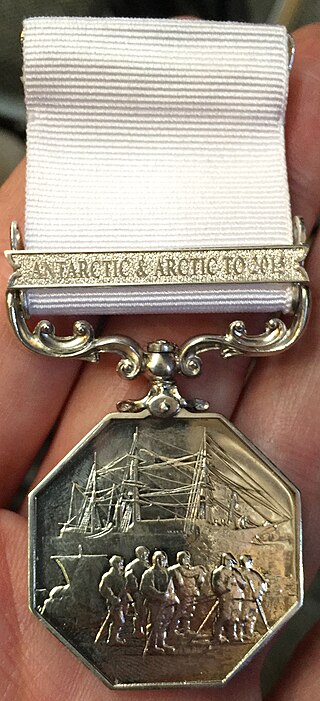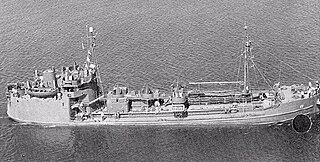
Richard Evelyn Byrd Jr., an American naval officer, was a pioneering American aviator, polar explorer, and organizer of polar logistics. Aircraft flights in which he served as a navigator and expedition leader crossed the Atlantic Ocean, a segment of the Arctic Ocean, and a segment of the Antarctic Plateau. He is also known for discovering Mount Sidley, the largest dormant volcano in Antarctica.

USCGC Healy (WAGB-20) is the United States' largest and most technologically advanced icebreaker as well as the US Coast Guard's largest vessel. She is classified as a medium icebreaker by the Coast Guard. She is homeported in Seattle, Washington, and was commissioned in 1999. On 6 September 2001 Healy visited the North Pole for the first time. The second visit occurred on 12 September 2005. On 5 September 2015, Healy became the first unaccompanied United States surface vessel to reach the North Pole, and Healy's fourth Pole visit happened on 30 September 2022.

Operation HIGHJUMP, officially titled The United States Navy Antarctic Developments Program, 1946–1947,, was a United States Navy (USN) operation to establish the Antarctic research base Little America IV. The operation was organized by Rear Admiral Richard E. Byrd, Jr., USN, Officer in Charge, Task Force 68, and led by Rear Admiral Ethan Erik Larson, USN, Commanding Officer, Task Force 68. Operation HIGHJUMP commenced 26 August 1946 and ended in late February 1947. Task Force 68 included 4,700 men, 70 ships, and 33 aircraft.

The McMurdo Sound is a sound in Antarctica, known as the southernmost passable body of water in the world, located approximately 1,300 kilometres (810 mi) from the South Pole.

The Krasin is a Russian icebreaker. The vessel operates in polar regions.

USCGC Polar Star (WAGB-10) is a United States Coast Guard heavy icebreaker. Commissioned in 1976, the ship was built by Lockheed Shipbuilding and Construction Company of Seattle, Washington along with sister ship, USCGC Polar Sea.

Terra Nova was a whaler and polar expedition ship. The ship is best known for carrying the 1910 British Antarctic Expedition, Robert Falcon Scott's last expedition.

The Polar Medal is a medal awarded by the Sovereign of the United Kingdom to individuals who have outstanding achievements in the field of polar research, and particularly for those who have worked over extended periods in harsh climates. It was instituted in 1857 as the Arctic Medal, and renamed the Polar Medal in 1904.

USS Edisto (AGB-2) was a Wind-class icebreaker in the service of the United States Navy and was later transferred to the United States Coast Guard as USCGC Edisto (WAGB-284). She was named after Edisto Island, South Carolina. The island is named after the Native American Edisto Band who inhabited the island and the surrounding area. As of 2011 there is a namesake cutter USCGC Edisto (WPB-1313). The newer Edisto is a 110-foot Island-class patrol boat and is stationed in San Diego County, California.

Jason was a Norwegian whaling vessel laid down in 1881 by Rødsverven in Sandefjord, Norway, the same shipyard which later built Ernest Shackleton's ship Endurance. The ship, financed by Christen Christensen, an entrepreneur from Sandefjord, was noted for his participation in an 1892-1893 Antarctic expedition led by Carl Anton Larsen.

SS Mission San Juan was a Type T2-SE-A2 tanker built for the United States Maritime Commission during World War II. After the war she was acquired by the United States Navy as USS Mission San Juan. Later the tanker transferred to the Military Sea Transportation Service as USNS Mission San Juan. She was a member of the Mission Buenaventura-class oiler and was named for Mission San Juan Bautista in San Juan Bautista, California.
SS Mission San Miguel was a Type T2-SE-A2 tanker built for the United States Maritime Commission during World War II. After the war she was acquired by the United States Navy as USS Mission San Miguel (AO-129). Later the tanker transferred to the Military Sea Transportation Service as USNS Mission San Miguel (T-AO-129). She was a Mission Buenaventura-class oiler and was named for Mission San Miguel Arcángel, located in San Miguel, California.

George John Dufek was an American naval officer, naval aviator, and polar expert. He served in World War II and the Korean War and in the 1940s and 1950s spent much of his career in the Antarctic, first with Admiral Byrd and later as supervisor of U.S. programs in the South Polar regions. Rear Admiral Dufek was the director of the Mariners' Museum in Newport News, Virginia after his retirement from the Navy in 1959.

Polar Class (PC) refers to the ice class assigned to a ship by a classification society based on the Unified Requirements for Polar Class Ships developed by the International Association of Classification Societies (IACS). Seven Polar Classes are defined in the rules, ranging from PC 1 for year-round operation in all polar waters to PC 7 for summer and autumn operation in thin first-year ice.
The International Code for Ships Operating in Polar Waters or Polar Code is an international regime adopted by the International Maritime Organization (IMO) in 2014. The Code sets out regulations for shipping in the polar regions, principally relating to ice navigation and ship design. The international framework aims to protect the two polar regions — the Arctic and Antarctic, from maritime risks. The Code entered into force on 1 January 2017.

The Maersk Peary is a tanker, operated by the shipping firm Maersk Line, that was designed for working in the polar regions.

The T1 tanker or T1 are a class of sea worthy small tanker ships used to transport fuel oil before and during World War II, Korean War and Vietnam War. The T1 tanker classification is still in use today. T1 tankers are about 200 to 250 feet in length and are able to sustain a top speed of about 12 knots. The hull designation AO is used by the US Navy to denote the ship is a T1 oil tanker and AOG that the T1 is a gasoline tanker. The small size allows the T1 to enter just about any sea port or to anchor around a small island, this was very useful during the Pacific War. The T1 tanker can carry about 48,000 to 280,000 bbls. Some T1 tankers were used to transport goods other than oil, a few were used for black oil-crude oil, diesel, chemicals and rarely bulk cargo like grain. T1 tankers are also called liquid cargo carriers. The T1 tanker has about a 6,000 to 35,000 deadweight tonnage (DWT) of cargo. The small size also gives the ships short turn around time for repair, cleaning, loading and unloading. A T1 tanker carrying dirty cargo, like crude oil needs a few weeks of labor to clean before carrying clean cargo. Most T1 ships during World War II were named after major oil fields.
Sun Laurel is a South Korean-owned oil tanker built in 2008 and currently operating under the flag of Vanuatu.

On 9 December 2019, a Chilean Air Force Lockheed C-130 Hercules military transport aircraft crashed in the Drake Passage while en route to Base Presidente Eduardo Frei Montalva, a Chilean military base on King George Island in Antarctica.

International competition extended to the continent of Antarctica during the World War II era, though the region saw no combat. During the prelude to war, Nazi Germany organised the 1938 Third German Antarctic Expedition to preempt Norway's claim to Queen Maud Land. The expedition served as the basis for a new German claim, called New Swabia. A year later, the United States Antarctic Service Expedition established two bases, which operated for two years before being abandoned. Responding to these encroachments, and taking advantage of Europe's wartime turmoil, the nearby nations of Chile and Argentina made their own claims. In 1940 Chile proclaimed the Chilean Antarctic Territory in areas already claimed by Britain, while Argentina proclaimed Argentine Antarctica in 1943 in an overlapping area.

















